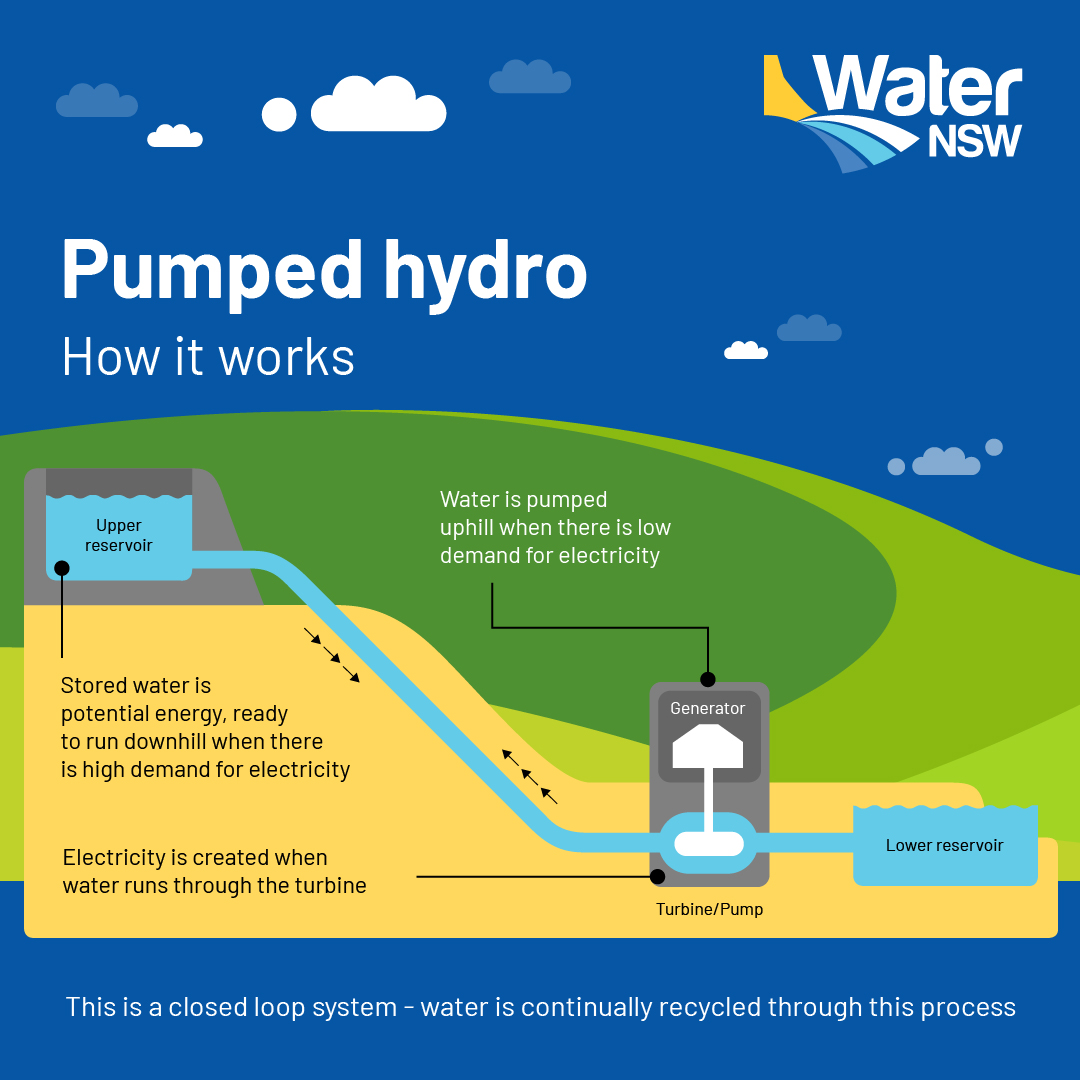The project is part of WaterNSW’s Renewable Energy and Storage Program, which aims to identify cost-effective, large-scale pumped hydro energy storage solutions using WaterNSW’s land and assets. These solutions have the potential to reduce energy emissions, create jobs and training opportunities in regional NSW, and help lower costs for both WaterNSW and energy customers.
The project is designed to provide:
- Sustained power output of 800 MW for 8.5 hours
- Maximum generation time of approximately 15 hours
- Stored energy capacity of 11,990 MWh
- Peak power output of 938 MW
It will include purpose-built, off-stream upper and lower storage reservoirs connected by a tunnel to a powerhouse with a pump-turbine unit. The project is expected to generate up to 600 jobs during peak construction and 50 long-term direct & indirect operational jobs.

Frequently asked questions
How much land will the project cover?
The upper and lower reservoir that will each cover a surface area of approximately 50ha and capable of holding up to 15,000ML of water, or 1% of Lake Burrendong.
Will the Phoenix Pumped Hydro project interfere with the operation of Burrendong Dam?
No. If constructed the project will have no impact on how WaterNSW operates Lake Burrendong or on the security of water entitlements for the valley.
Is the Phoenix Pumped Hydro project located in a Renewable Energy Zones?
The Project is located within the Central-West Orana REZ and, if constructed, will provide the long duration storage required to support renewables penetration in this region.
How much will the project cost if approved?
Approximately $1.8 billion.
Is WaterNSW funding the project?
No. WaterNSW awarded the contract to ACEN Australia Pty Ltd to develop the project on WaterNSW owned land following an extensive competitive tender process. Should it be constructed, the project will play an important role in assisting with the delivery of New South Wales energy ambitions.
Does the project consume more electricity than it generates?
Pumped hydro has long been recognised as both a very efficient and effective part of electricity systems, balancing times of low and high electricity supply from variable energy sources, whilst also assisting grid reliability and stability. This is increasingly important in regions where intermittent renewables (large scale wind and solar farms) produce a large proportion of the region’s electricity consumption.
As more electricity is needed to pump the water up the hill than is produced moving the water down the hill, the facility is a net user of electricity. However, these plants are incredibly efficient (at around 80%) and can be made available in only a matter of minutes, making it very competitive with other energy storage options such as battery storage.
Why is pumped hydro required?
NSW’s energy system is going through an energy transformation driven by the exit of coal and other emissions intensive generation sources. The NSW Government has signalled that over the next 15 years, four of the five coal fired power stations which currently provide around three quarters of the State’s energy supply, will retire.
Intermittent renewable energy, including solar and wind generation, will in large part replace this generation and will play an important role in helping the NSW Government’s ambitions to reach net zero emissions by 2050. However, the variability of generation from intermittent renewable sources, means that it is not necessarily available on demand.
Investment in complementary forms of short and long duration electricity storage, such as pumped hydro, is therefore important to ensure surplus renewable energy can be stored and to ‘even out’ fluctuations’ in generation. Furthermore, pumped hydro energy storage provides a range of essential network services that may not be able to be provided by intermittent renewable energy sources. These play a critical role in helping to deliver NSW energy consumers a secure and reliable network.
How would this project help in the development of renewable energy?
Many renewable technologies, such as wind and solar, provide what is known as intermittent generation. This means that they are not capable of providing generation on-demand. This may be because the wind isn’t blowing or the sun isn’t shining.
A modern energy grid that is powered by renewables must be capable of providing energy on-demand to consumers. Pumped hydro energy storage can play an important role in delivering this outcome.
Pumped hydro energy storage has the ability to support the ongoing deployment of renewable energy through acting as a source of demand. This surplus renewable energy can then be released during times when it is needed to ensure that energy supply meets demand.
WaterNSW is seeking private sector investment in renewable energy generation and/or storage projects, such as pumped Hydro on WaterNSW land and assets.
WaterNSW acknowledges the traditional custodians of the lands and waters on which we work and pay our respects to all elders past, present and emerging. Learn more
